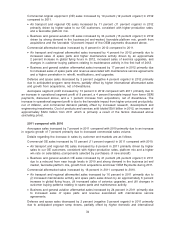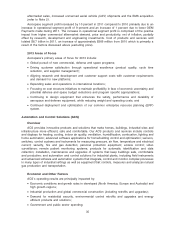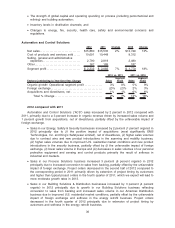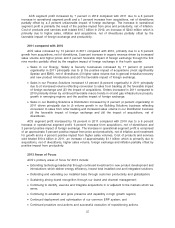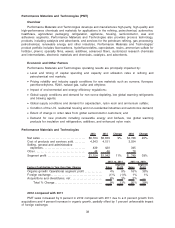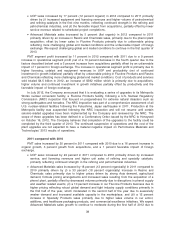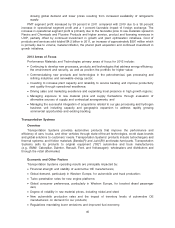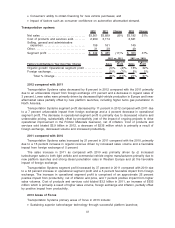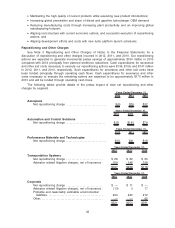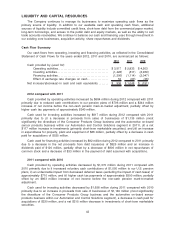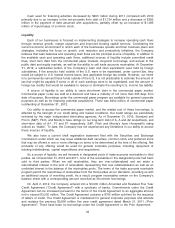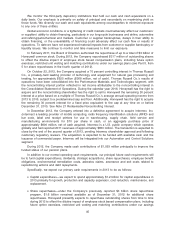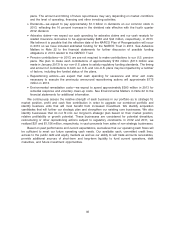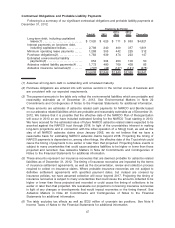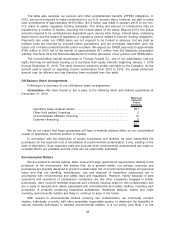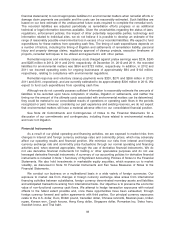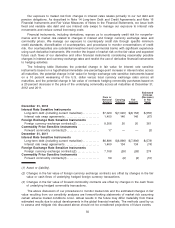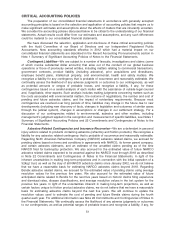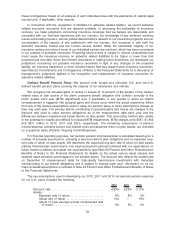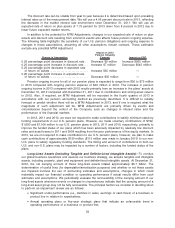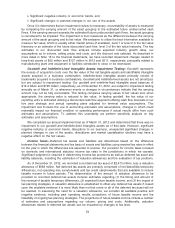Honeywell 2012 Annual Report Download - page 53
Download and view the complete annual report
Please find page 53 of the 2012 Honeywell annual report below. You can navigate through the pages in the report by either clicking on the pages listed below, or by using the keyword search tool below to find specific information within the annual report.Cash used for financing activities decreased by $933 million during 2011 compared with 2010
primarily due to an increase in the net proceeds from debt of $1,734 million and a decrease of $293
million in the payment of debt assumed with acquisitions, partially offset by an increase of $1,085
million of repurchases of common stock.
Liquidity
Each of our businesses is focused on implementing strategies to increase operating cash flows
through revenue growth, margin expansion and improved working capital turnover. Considering the
current economic environment in which each of the businesses operate and their business plans and
strategies, including the focus on growth, cost reduction and productivity initiatives, the Company
believes that cash balances and operating cash flows are the principal source of liquidity. In addition to
the available cash and operating cash flows, additional sources of liquidity include committed credit
lines, short term debt from the commercial paper markets, long-term borrowings, and access to the
public debt and equity markets, as well as the ability to sell trade accounts receivables. At December
31, 2012, a substantial portion of the Company’s cash and cash equivalents were held by foreign
subsidiaries. If the amounts held outside of the U.S. were to be repatriated, under current law, they
would be subject to U.S. federal income taxes, less applicable foreign tax credits. However, our intent
is to permanently reinvest these funds outside of the U.S. It is not practicable to estimate the amount of
tax that might be payable if some or all of such earnings were to be repatriated, and the amount of
foreign tax credits that would be available to reduce or eliminate the resulting U.S. income tax liability.
A source of liquidity is our ability to issue short-term debt in the commercial paper market.
Commercial paper notes are sold at a discount and have a maturity of not more than 365 days from
date of issuance. Borrowings under the commercial paper program are available for general corporate
purposes as well as for financing potential acquisitions. There was $400 million of commercial paper
outstanding at December 31, 2012.
Our ability to access the commercial paper market, and the related cost of these borrowings, is
affected by the strength of our credit rating and market conditions. Our credit ratings are periodically
reviewed by the major independent debt-rating agencies. As of December 31, 2012, Standard and
Poor’s (S&P), Fitch, and Moody’s have ratings on our long-term debt of A, A and A2 respectively, and
short-term debt of A-1, F1 and P1 respectively. S&P, Fitch and Moody’s have Honeywell’s rating
outlook as “stable”. To date, the Company has not experienced any limitations in our ability to access
these sources of liquidity.
We also have a current shelf registration statement filed with the Securities and Exchange
Commission under which we may issue additional debt securities, common stock and preferred stock
that may be offered in one or more offerings on terms to be determined at the time of the offering. Net
proceeds of any offering would be used for general corporate purposes, including repayment of
existing indebtedness, capital expenditures and acquisitions.
As a source of liquidity, we sell interests in designated pools of trade accounts receivables to third
parties. As of December 31, 2012 and 2011, none of the receivables in the designated pools had been
sold to third parties. When we sell receivables, they are over-collateralized and we retain a
subordinated interest in the pool of receivables representing that over-collateralization as well as an
undivided interest in the balance of the receivables pools. The terms of the trade accounts receivable
program permit the repurchase of receivables from the third parties at our discretion, providing us with
an additional source of revolving credit. As a result, program receivables remain on the Company’s
balance sheet with a corresponding amount recorded as Short-term borrowings.
On April 2, 2012, the Company entered into a $3,000 million Amended and Restated Five Year
Credit Agreement (“Credit Agreement”) with a syndicate of banks. Commitments under the Credit
Agreement can be increased pursuant to the terms of the Credit Agreement to an aggregate amount
not to exceed $3,500 million. The Credit Agreement contains a $700 million sub-limit for the issuance
of letters of credit. The Credit Agreement is maintained for general corporate purposes and amends
and restates the previous $2,800 million five year credit agreement dated March 31, 2011 (“Prior
Agreement”). There have been no borrowings under the Credit Agreement or the Prior Agreement.
44


